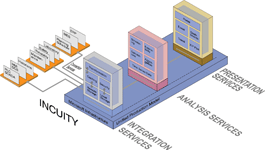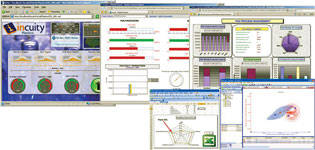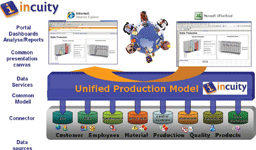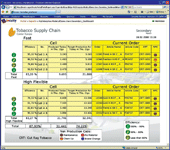

Débuting at Rockwell’s Automation University held at Emperor’s Palace in August was newly acquired Incuity. This is a truly South African success story whose beginnings can be traced back to Professional Technology Management, which was founded by Doug Lawson in 1991.
Incuity history
Professional Technology Management (PTM) developed the Prealism plant data server – an object-oriented historian software product designed for gathering large volumes of realtime production data from manufacturing or process operations. Prealism used proprietary compression and storage technologies to handle the high data rates and quantities of data generated by manufacturing and process applications and to write this data to Microsoft’s SQL Server database. The elegance of this approach was that it ensured that data could subsequently be read using standard SQL queries. And standards are something that Incuity’s team firmly believe in.
In December 1995 Wonderware bought PTM and its intellectual property rights for an undisclosed sum and hired the company’s six-person staff to continue product development within Wonderware's R&D group. Absorbed into Wonderware, this became Wonderware’s IndustrialSQL Server historian.
Lawson established DataWorks Systems in 1998, and created the ActiveFactory client application for manufacturing data analysis, trending and reporting. DataWorks was re-incorporated as Incuity Software in 2004. The company’s flagship Incuity EMI (enterprise manufacturing intelligence) product was launched in 2006. At the launch Lawson described the product as, "'… the 'Swiss Army knife' of business intelligence systems for manufacturing companies, linking the database world of enterprise business systems and the object-oriented world of automation and control systems in a single, coherent environment against which users can program."
Incuity Software currently has over 45 000 seats of its products installed in more than 40 countries with support for 13 languages.
Rockwell acquisition
In April this year Rockwell Automation announced that it was acquiring Incuity Software and retaining the Incuity Software management team and their employees, who will become part of Rockwell Automation’s Architecture & Software operating segment.
Kevin Roach, VP, Rockwell Software described the acquisition as a key milestone in the continued expansion of the Rockwell FactoryTalk software suite. Steve Eisenbrown, senior vice president of the company’s Architecture & Software segment says, “Incuity Software products do not just provide visibility – they deliver enterprise-level insight by combining operations data with ERP and other IT applications. They make it possible to find the valuable insight hidden between disconnected information sources.”

IncuityEMI
Putting aside the hype let us look at what the software suite does and how it can help the enterprise.
In the manufacturing plant the call of an earlier era was the need to pull together islands of automation. To a large extent the growth in communications capabilities and the general adoption of Ethernet, linking PLC/PAC to scada has achieved this. But at the plant level there are still stranded sources of data and at the enterprise level there remains the possibility of aggregating data across plants and other data sources to help inform optimal decision making.
IncuityEMI is a software suite that helps with this accumulation of data from disparate sources in ways that do not need programmers and long-term software development projects. By pulling together data from production systems (PLCs/PACs, scada), laboratory information management systems (LIMS), SPC systems, historians, MES, maintenance and planning systems, enterprises can convert data into information and information into business intelligence and key operational metrics (KPIs). At the same time this approach reduces production waste, eliminates wasted data entry effort (manually capturing data – often into multiple systems), improves business systems, and reduces errors.
The key to doing this successfully is to gather data and disseminate intelligence by adopting a service oriented architecture and embracing industry standards such as OPC DA and HDA, S95, Open Source, Object Management Group, ActiveX (for legacy purposes), Microsoft .NET and Web Services, as well as de facto standards like Microsoft Office interfaces so that solutions can be configured, rather than programmed.
Data in
The company’s philosophy for Incuity is that it should obtain data in a non-invasive way. By that they mean that the existing control, automation and other data sources should not require reconfiguring in order to interface to their manufacturing intelligence system.
To accommodate the many different types of data 'silo', with their different characteristics of data throughput, frequency and time domains, Incuity uses a range of standard data connector technologies such as OPC DA, OPC HDA, Oracle and MS SQL Server. There is also a toolkit so that purpose-built connectors can be created for applications such as maintenance systems, quality systems and scheduling systems.
For the familiar production realtime data sources like PLCs, HMIs, DCS and scada connection is through an application specific connector or via OPC DA. Plant historians are typically connected through an historian specific connector or OPC HDA. Manufacturing management applications, such as maintenance management systems, quality and reliability applications, scheduling systems, safety systems and LIMS use application specific connectors. ERP systems hook up via application specific connectors. The generic database connectors provide integration for database applications built using Oracle or SQL Server.
Intelligence built into the connectors allows the connector to be aware of the data definition of the source data and it is thus able to correctly map the data into the Incuity server.
Selected connectors are bi-directional, which means that data can be read from and written to the sources in their native protocols. This facilitates simple transactions, such as changing a value in a client and downloading that change into a PLC, or more complex transactions such as writing changed data back into SAP.
Through the integration services, incoming data can be cleaned and reformatted if required. Integration services also include security services and user management, roles and data access.
An important distinction that Incuity possesses is that though its unified production model (UPM) approach it does not store a copy of the data received, which would open up opportunities for data divergence, but rather accesses data at source.

Data analysis
To gain knowledge from data the software’s analysis services provide correlation between data from differing sources and in different time domains, as well as calculation capabilities, transformations, summaries and data aggregation.
Intelligence out
Intelligence is provided to decision makers through trends, plots, dashboards, reports or via an Excel add-in.
Reports, views and dashboards can all be published to the web, allowing authorised users access via the Incuity or SharePoint portal.
Developers and third party applications can access the data via standard web services, and standard scripting and object, OLAP and relational query interfaces.

Trends
Trends can include realtime or historical data. A significant capability of the trend module from an enterprise intelligence consideration is the ability to display multiple trends with multiple time axes. This allows comparison of, for instance, current process conditions for a batch vs. those of a prior batch.
Management can also benefit from the fence-posting abilities of the trend module. This makes it easy to identify significant global events like batch start, batch completion or shift changes and to observe the influence of these on manufacturing efficiency.
XY plots
The XY plotter is a browser client application that allows users to view realtime data such as the interaction between pairs of tags, the ability to overlay a user-defined boundary envelope over the tag-pair display to allow users to identify normal/abnormal or optimal/suboptimal process conditions.
Traces can be saved as 'Golden Batch' to provide process operators with templates for running their processes optimally.

Dashboards
The dashboard concept has been widely adopted in business and manufacturing intelligence systems to provide dynamic displays of KPIs. The Incuity dashboard objects include an array of dials, sliders, charts and graphs. Dashboards are configured though a wizard.
Incuity Portal
The portal allows authorised users web access to published intelligence. The concept of publishing relevant manufacturing intelligence to management and operations is, after all, the rationale for adopting an enterprise manufacturing intelligence system.
The Incuity portal can be deployed as a standalone portal or included in other portals like Microsoft SharePoint.
Report generation can be on-demand, time-scheduled or event-based and output can optionally be directed to email.
Excel add-in
The Excel add-in allows users to integrate data from defined data sources such as control systems, historians and business applications and to manipulate that data using Excel functionality.
Processed data, including automatically refreshed realtime reports can then be published through a selected portal.
“Last year South Africa was Rockwell’s EMEA country of the year and software sales, especially of higher level systems like FactoryTalk AssetCentre have been growing strongly. We are really excited about being able to offer Incuity to our existing and prospective customers.”
For more information contact Deon Engelbrecht, Rockwell Automation, +27 (0)11 654 9700, [email protected], www.rockwellautomation.co.za
Sources: www.incuity.com and product literature.
| Tel: | +27 11 998 1000 |
| Email: | [email protected] |
| www: | www.rockwellautomation.co.za |
| Articles: | More information and articles about Rockwell Automation |

© Technews Publishing (Pty) Ltd | All Rights Reserved